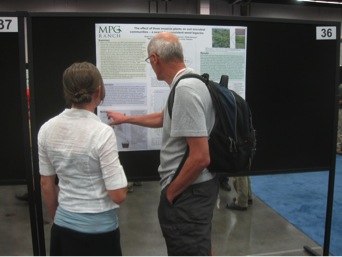
MPG Ranch Presents at ESA Conference
Block title
 By: Ylva LekbergPh.D. Ecologist
By: Ylva LekbergPh.D. EcologistAlexii Cornell, Lauren Stoffel and I attended the Ecological Society of America conference (http://www.esa.org/portland/) last week in Portland, OR. The conference included 4,500 enthusiastic ecologists and more than 30 concurrent sessions. We focused on presentations in invasion biology and restoration ecology that are relevant for issues at MPG Ranch. I learned that many exotic plant traits differ from native plants (abstract), and that trade-offs in biotic interactions may allow for the coexistence of the two groups. Martin and Wilsey (abstract) found that exotic plants suffer more from predation than native plants. This finding is controversial as it contradicts the enemy release hypothesis.
I presented work showing that arbuscular mycorrhizal (AM) fungal communities associated with exotic plants differ in abundance and composition from each other and native communities. Alexii’s poster compared microbial communities between the field and greenhouse. The poster showed significant differences between exotic and native plants and questioned the utility of greenhouse studies to assess field conditions . Her timely and relevant work generated a lively debate among researchers.

Photo 1. Alexii Cornell discusses research findings at the ESA conference.
Lauren (Photo 2) presented work she and Dan Mummey conducted to assess the bridge species role of sainfoin (Onobrychis sativa) during restoration from crested wheatgrass (Agropyron cristatum) and cheatgrass (Bromus tectorum). Uselman et al. (abstract) also discussed restoration using early seral native species that may be better cheatgrass competitors. Lauren's favorite presentation showed that seed caching rodents increase the survival of Indian ricegrass (Achnatherum hymenoides; abstract).

Photo 2. Lauren Stoffel displays her poster.
The conference generated many stimulating discussions with peers, and we look forward to the next ESA Conference.

About the AuthorYlva Lekberg
Ylva graduated from the Swedish University of Agricultural Sciences with a M.Sc. in Biology and Horticulture in 1996 and a Ph.D. in Ecology from Penn State University in 2004. She received the Alumni Association Dissertation Award for her work in agroecology and subsistence farming in Sub-Saharan Africa. Post-doctoral positions at Montana State University and later at Copenhagen University as a Marie Curie Fellow allowed her to explore the role of arbuscular mycorrhiza, a root-fungus symbiosis, for geothermal plants in Yellowstone National Park and coastal grasslands in Denmark. Her research has been published in international journals such as Nature Communications, Ecology Letters, and New Phytologist.
Ylva joined MPG Ranch in 2010. Since then, she has explored how invasive plants common to western Montana, including spotted knapweed (Centaurea stoebe), leafy spurge (Euphorbia esula) and cheatgrass (Bromus tectorum), influence soil microbial community composition and function, and how this in turn may affect invasive success. A lot of her research also focuses on the AM symbiosis in terms of community ecology and physiology. A current project addresses how exchange ratios in this symbiosis may differ among co-occurring plants and depend on soil nutrient availabilities. She uses surveys, field and greenhouse experiments, and literature approaches such as meta-analyses to address questions. To learn more about research and publications from Ylva and her group, see CV below and the Soils, Plants and Invasion section.
In addition to her work at MPG Ranch, Ylva is an adjunct professor at University of Montana at the Department of Ecosystem and Conservation Sciences.
Ylva joined MPG Ranch in 2010. Since then, she has explored how invasive plants common to western Montana, including spotted knapweed (Centaurea stoebe), leafy spurge (Euphorbia esula) and cheatgrass (Bromus tectorum), influence soil microbial community composition and function, and how this in turn may affect invasive success. A lot of her research also focuses on the AM symbiosis in terms of community ecology and physiology. A current project addresses how exchange ratios in this symbiosis may differ among co-occurring plants and depend on soil nutrient availabilities. She uses surveys, field and greenhouse experiments, and literature approaches such as meta-analyses to address questions. To learn more about research and publications from Ylva and her group, see CV below and the Soils, Plants and Invasion section.
In addition to her work at MPG Ranch, Ylva is an adjunct professor at University of Montana at the Department of Ecosystem and Conservation Sciences.



















